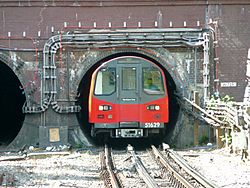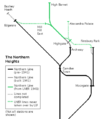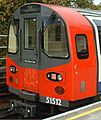Northern line facts for kids
Quick facts for kids Northern line |
|
|---|---|

1995 Stock leaving the tunnel north of Hendon Central
|
|
| Overview | |
| Stations | 50 |
| Colour on map | Black |
| Website | tfl.gov.uk |
| Service | |
| Type | Rapid transit |
| System | London Underground |
| Depot(s) | Golders Green, Morden; sidings at Edgware, Colindale, Hampstead, Chalk Farm, High Barnet, East Finchley, Archway, Camden Town, Euston (Bank branch), Moorgate, Charing Cross, Kennington, Tooting Broadway |
| Rolling stock | 1995 Stock |
| Ridership | 252.310 million passenger journeys (2011/12) |
| History | |
| Opened | 18 December 1890 (as City and South London Railway) 28 August 1937 (renamed to Northern line) |
| Last extension | 1926 |
| Technical | |
| Line length | 58 km (36 mi) |
| Character | Deep-tube |
| Track gauge | 1,435 mm (4 ft 8 1⁄2 in) |
| Operating speed | 45 mph (72 km/h) |
The Northern line is a very busy train line on the London Underground system. It's easy to spot on the Tube map because it's coloured black. This line carries a huge number of people, more than any other Underground line. Over 250 million passengers use it every year!
The Northern line is mostly a "deep-level tube line." This means its tunnels are dug deep underground, unlike some other lines that run closer to the surface. The oldest part of the Northern line, between Stockwell and Borough, opened way back in 1890. This makes it the oldest deep-level tube section in the whole Underground network.
Contents
About the Northern Line
The Northern line is one of the busiest lines in London. In 2011/12, about 252 million journeys were made on it. For several years, from 2003 to 2010, it was actually the busiest line of all!
One special thing about the Northern line is that it has two different routes through the centre of London. This helps it serve more areas. Even though it's called the "Northern" line, it doesn't go to the very northernmost stations on the Underground. However, it does reach the southernmost station, Morden. It also serves 16 out of the 29 stations located south of the River Thames.
In total, the Northern line has 50 stations. Out of these, 36 stations have platforms that are deep underground.
History of the Line
The Northern line has a long and interesting history. Its current shape, with different branches in the north and two routes through central London, comes from how it was built. It started as three separate railway lines. These lines were later joined together in the 1920s and 1930s to form what we know today as the Northern line.
An extension built in the 1920s used a path that was originally planned by a fourth railway company. There were also plans in the 1920s and 1930s to extend the line even further, both north and south. These plans would have included parts of two more railway companies' routes.
From the 1930s to the 1970s, tracks from yet another company were also managed as part of the Northern line. This shows how many different parts came together to create this complex line.
Future of the Northern Line
Currently, there's a new extension being built from Kennington to Battersea. This project is called the Northern line extension to Battersea. Once it's finished, the Northern line might get a second branch in the south. It's also possible that the line could be split into two separate lines, each with its own name and identity. This would change how people travel across London.
Images for kids
See also
 In Spanish: Northern Line para niños
In Spanish: Northern Line para niños







